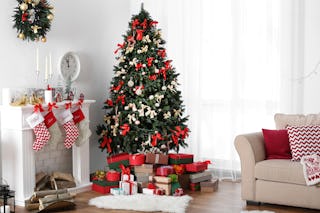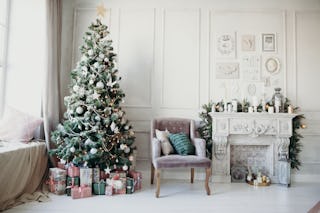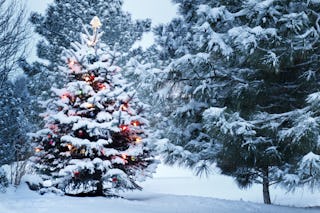
What’s the first thing many people do to celebrate Christmas? Decorate a Christmas tree, of course! Many families head out right after Thanksgiving to pick out their perfect tree or decorate the artificial one they pull out of storage.
From the “Charlie Brown” tree to lighting ceremonies, Christmas trees are a huge part of our culture. But why? How did they become so ingrained in our holiday traditions?

The History of Christmas Trees
The first traditions related to Christmas trees didn’t have religious associations. People in the ancient world revered evergreen trees, which stayed green throughout the winter. So they hung pine, spruce, and fir tree boughs over their doors and windows to keep away witches, ghosts, and illnesses.
They were also used to celebrate the Winter Solstice, which was the shortest day and longest night of the year in the Northern Hemisphere. The evergreen boughs would remind people of green plants that would grow again after Winter, a symbol of hope for the coming of Spring.
The idea of decorating a tree for Christmas actually began in Germany, where they used to add fruits and nuts to trees outside once the leaves fell off. Why? The Germans also wanted to symbolize Spring’s fast approach!

But in 1605, a fir tree was brought inside and decorated with paper roses, candles, nuts, and fruits, a groundbreaking idea that took off and spread across Germany.
German immigrants brought the Christmas tree to the United States when moving to Pennsylvania in the 1830’s. At the time, they still used candles, nuts, berries, or whatever was handy around the house (like bits of metal and paper) to decorate.
But the Christmas tree took a while to take off in the U.S. because of its associations with pagan traditions. In fact, in previous years, the governor of the New England Puritans, William Bradford, penalized anyone who celebrated “heathen” traditions (like Christmas trees and decorations!) around the holidays.
In 1846, the London News published an illustration of Queen Victoria standing around a Christmas tree with her family. To Americans, anything the royals did was revered so, of course, Christmas trees spread like wildfire!

One day, a man by the name of Mark Carr, who lived in the Catskill Mountains, realized that there was a way to commercialize Christmas trees. He started cutting down fir and spruce trees that were readily available in the Catskills, and took them to New York City. There, he rented a small space for $1.00 and sold the trees for anywhere from 5 cents to 25 cents, depending on their size.
And so Christmas trees became even more prevalent across the United States.
In 1923, First Lady Grace Coolidge gave permission for Washington D.C. public schools to place a Christmas tree on the ellipse south of the White House. They called it the National Christmas Tree and President Coolidge “pushed a button” to light the 48-foot Balsam fir as spectators watched.

Of course, this became a tradition and the ceremony grew year after year. The National Tree Lighting Ceremony used cut trees until 1973 and now uses a planted, live blue spruce tree.
Fun Fact: Originally, Teddy Roosevelt banned the Christmas tree from the White House for environmental reasons.
Types of Christmas Trees
There are a variety of types of trees used across the United States, but here are a few of the most popular.
Fraser Fir — The most popular variety. It’s hardy enough to be cut and shipped across the country. The Fraser fir is known for its dark green needles, which are ½ to 1 inch long.
Douglas Fir — Not actually a true fir, the Douglas fir has conical branches that hang downward and a sweet scent when the branches are crushed.
Balsam Fir — A pyramidal tree with short, flat, long-lasting, aromatic needles. It’s very similar to the Fraser fir and is dark green and fragrant.
Colorado Blue Spruce — Planted as “live” Christmas trees. Blue spruces have dark green to powdery blue needles and are often sold with the entire root ball, designed to be planted outdoors.

Then, of course, many families use artificial trees! The artificial tree was created in 1800’s Germany after people realized that real Christmas trees were destroying tree populations. The first artificial tree was made of goose feathers, but people searched for a better model.
A company called Addis, who was known for making the first toilet bowl brushes, used a similar method to create artificial Christmas trees that were a bit more similar to what we use today.
In the 1960’s, silver aluminum pine trees became popular and really made the artificial tree common in America. It included a revolving light underneath the base that changed colors!
And now, of course, many people choose artificial trees because they don’t produce fallen needles, are better for allergies, and cost less over time. They can also come with a pine scent built in! And there are a variety of styles – different colors (even neon!), iced trees designed to look like they’re covered in snow, pre-wired trees and more.
Fun Fact: Americans buy about 20 million real Christmas trees each year.

Christmas Trees Around the World
Christmas trees are a wonderful way to showcase both individual family traditions as well as cultural traditions. And countries decorate and use them in different ways around the world!
Brazil — Pine trees are decorated with pieces of cotton to look like snow.
China — While few celebrate Christmas in China, those that do typically use artificial trees decorated with paper chains, flowers, and lanterns.
Norway — People in Norway typically cut their own Christmas trees. They’re decorated on Christmas Eve by parents while children wait in another room. Then, the whole family joins hands and walks around the tree singing Christmas carols.
Ukraine — It’s common to decorate Christmas trees with sparkly spider webs and spiders, which represent good luck. This is based off of a fairytale about a Christmas spider web that turned to gold on Christmas morning.
Australia — There, Christmas falls in the summer. So they often use shells and other beach, summer décor to adorn their trees.
Fun Fact: In the 19th century, Americans typically had trees that reached to the ceiling while Europeans’ trees were often around 4 feet tall.